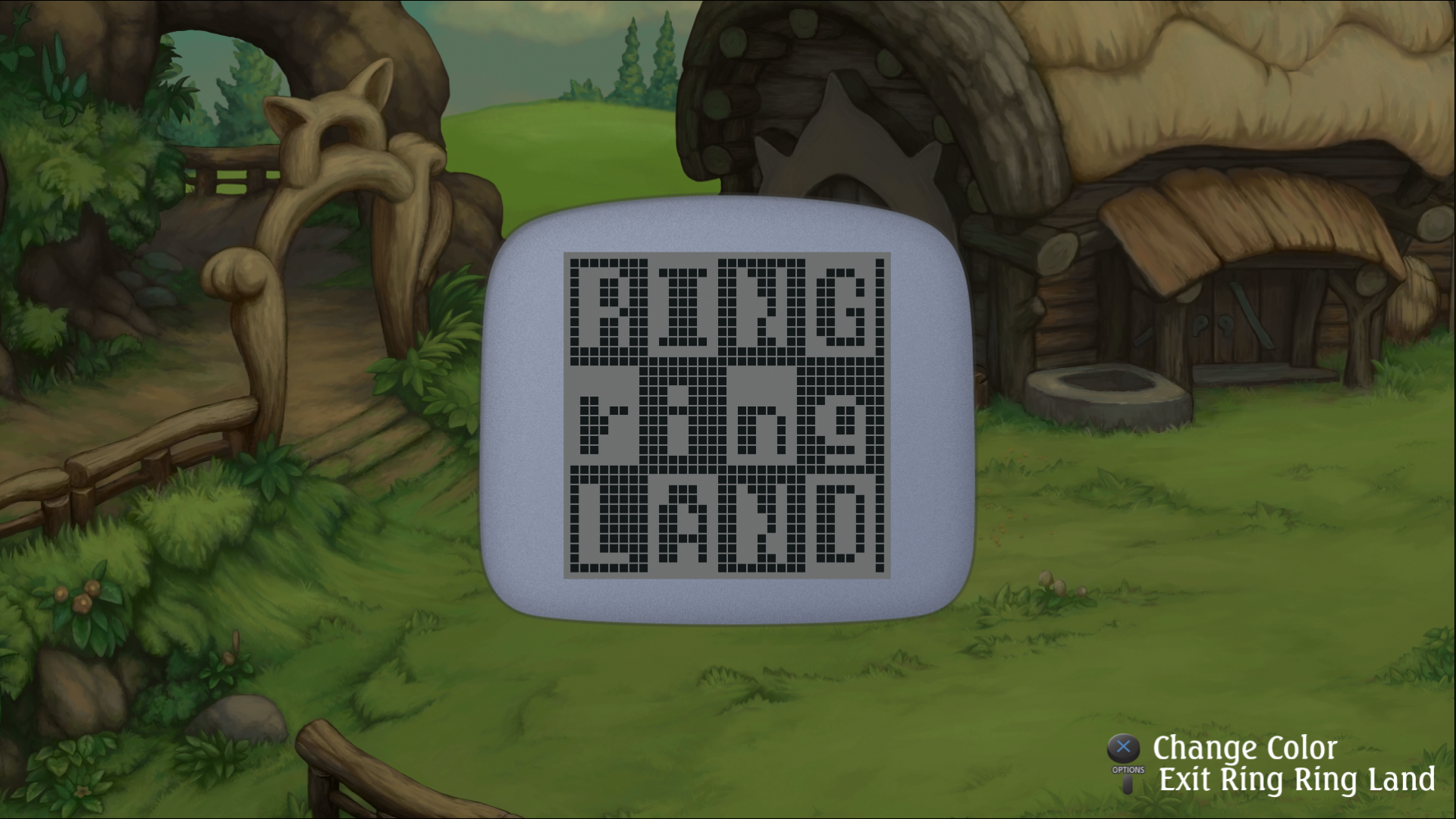Legend of Mana is an RPG that was originally released in 1999 for the PlayStation and garnered a wide following as part of Square’s Mana series of games. The fourth installment of the series, Legend of Mana was, understandably, quite a head-scratcher for many fans of the previous games as it didn’t feature a linear storyline. Instead, it opted to focus on a narrative centered around a multitude of side quests and a world that you quite literally create.
Aside from a few quirks, Legend of Mana was undoubtedly a hit. So much so that Square Enix announced back in February 2021 that an HD remaster of the game would be coming to PS4, Nintendo Switch, and PCs. The remastered game boasts updated HD backgrounds, an entire arranged orchestral soundtrack, and a whole host of quality of life improvements and menu options. It even brings Ring Ring Land, an optional companion game for the PocketStation, to Western audiences for the first time in the form of a playable mini-game. How cool is that!
In this review, I’ll try my best to avoid criticism about the game itself; rather, I’ll try to focus on the changes and additions made specifically for the Legend of Mana HD remaster. However, I will still be covering some aspects of the game that I consider issues that could or should be addressed in this release, namely about navigation and game mechanics. In other words, if it was considered badly done in the original game, then it better be gone or fixed in this version.
Legend of Mana Review – Art Brought to Life
The detail and beauty of Legend of Mana‘s artwork are, of course, undisputed. Even in its original release, the game had some impressive pixel design that drew inspiration from artbooks and classic Disney animation. The vibrant colors and unique flora and fauna designs do a fantastic job of immersing the player in the game’s virtual storybook.
The remastered game provides even greater fidelity to the already detailed art of the game, overhauling practically every location in the game. It stays truthful to the original art, too, down to the minute details of things like the cups and food in the main character’s living room. Square Enix shared a few comparisons on their official Japanese website, but it seems as though the dev team drew over the original background art to get a “storybook aesthetic”. Character art in dialogue boxes has also received the same treatment and is a wonderful improvement on the game’s already stellar character designs.

One of the only gripes I have about the graphics in this new remaster, however, is how the high-definition artwork can look incredibly out of place next to the pixel art style of characters and enemies. The original game had pixel art for both foreground objects (ie. characters, enemies), as well as background art that made it look consistent. With the remaster, however, I kept getting distracted by the fact that my comparatively blocky, 16-bit character popped out a little too much.
In some cases, the HD backgrounds also felt a little lazy and almost less detailed than their originals. This is likely because the HD remaster had to “fill in” certain details that were left out due to the rather limited graphics capabilities of the original game. It’s not a deal-breaker of course, but in some instances, it would border on looking like an unfinished sketch made by someone who was overly enthusiastic about the photoshop smudge tool.
The game’s music has also been revamped, and I can confidently say that in this corner, Square Enix did a very good job. The new soundtrack features orchestral performances of all of the original soundtracks featuring new arrangements with plenty of added instrumentation and vocals. All of these compositions can also be enjoyed directly from the game’s menu at any point during the course of the game. Best of all, players also have the choice to play the game with the newly arranged or original soundtracks and can change them on the fly whenever they want.
Legend of Mana Review – A Story That Makes Sense
One of the more grating aspects of the original game was just how “disjointed” its story was. Part of it was due to the fact that there were so many intertwining stories that would expand on the lore of the world. Another important aspect was how poorly done the localization was. While not all games are going to be perfect, Legend of Mana in particular suffered from a severe case of tone inconsistency that would make some dialogue lines feel incredibly out of place. Others, while they might have made sense in the original Japanese text, ended up as complete gibberish in English.
The HD remaster fixes a lot of these issues by re-localizing most of the game’s dialogue, even down to some character names. The most notable change early on is that one of the seven wisdoms, Gaeus, who was called Gaia in the Japanese version, is now officially called Gaia in the English version as well. Other minor changes have also been made to phrasing to make sentences sound more natural, and give characters a little more consistency.


One big change I found was when I was going through the Tower of Leires storyline and found that Pearl’s dialogue made so much more sense. Rather than making disjointed sentences that were direct translations of the original Japanese text, the English localization now gives a few more context clues alluding to Pearl’s lost memory. While the game still occasionally suffers from “what the hell happened just now” syndrome, having dialogue that makes sense goes a long way in introducing the game to new audiences.
Legend of Mana Review – Making Life Easier
The best change made in the remaster by far is the ever-present menu options that can be accessed via the touchpad. These include simpler additions, like the addition of a convenient “How to Play” guide that teaches you everything you need to know about combat and controls. It also includes the game-changing, life-saving addition of an autosave function, as well as the option to disable encounters.
The latter two are particularly helpful for a game like Legend of Mana, where back-tracking through an area is more of an inevitability than an option. Each location or “land” in the game is made up of several interconnected “rooms” that can have enemies and loot in them. Because a majority of these maps are more than likely to have some element of puzzle-solving to them, this results in a lot—and I mean a LOT—of running around trying to find out where the hell you’re supposed to go or who to talk to, which also means fighting a battle every. single. time. you enter a monster room. Now if you get lost in a map, you can simply switch the encounters off and focus more on exploring without having to worry about getting interrupted.

About to start a boss fight but don’t have any save points nearby? The save data menu has got you covered, buddy. Instead of having to trek all the way back to your nearest save statue, players can now save their games wherever they want, whenever they want. And even if you forgot to make that save right before heading face-first into a boss fight, the auto-save function will always let you go back to the previous room that you were in.
That’s not all the new menu offers, either. Two-player co-op, a feature that existed in the original game, is also managed largely through the main menu. In it, players can determine whether they wish for their companion to be controlled by the game’s AI, or if they’d like someone with a second controller to control the character. If you’re used to how it was in the original game, you can also manage these settings in the Mana’s Blessing Inn in Domina, but going to the Inn is no longer required for a second person to play.

Then, there’s also the Ring Ring Land mini-game. Ring Ring Land was a spin-off game for the PocketStation device which was exclusive to Japan. It allowed players to transfer their pets to the handheld device, and play a fairly simple board game that would gift rewards such as seeds and fruits based on luck. The player’s pet would bring these rewards back in-game to be used in Legend of Mana. Unfortunately, the spin-off game was not made available for English versions of the game. That is, of course, until now, where it’s part of this re-release.
Of course, there are still some things that I wish were fixed in the HD remaster. Namely the god-awful hitboxes of enemies that are just a few pixels too high to hit, and the fact that companions will leave you without warning when you enter your tree house. I’d wager a guess that these things were likely kept either because it was too much of a hassle to change the base code of the game, or simply because that’s what fans expect at this point. I wouldn’t necessarily call them game-breaking issues, but more like quirks that you get used to over time.
For the most part, the changes that the new HD remaster brings are welcome ones. Not only because these changes add and improve upon what makes Legend of Mana a good game, but because they also make the game accessible to both new and returning players. Not only that, the game also gives you the choice to play it however you’d like, be it the orthodox way using no autosaves, or by utilizing the new QoL changes. These changes are more important than any other combat system revamping, or inclusion of a new skill system because, at the end of the day, Legend of Mana‘s strength isn’t in its combat or game systems. It’s in the characters, the locations, and the stories that it’s been telling, and will tell for years to come.
Legend of Mana review code provided by publisher. For more information, please read our Review Policy.
-
Highly detailed background art that looks great
-
Arranged music improves already great soundtrack
-
Quality of life changes
-
Solid Localization
-
New art can occasionally look out of place
-
Combat is still janky like the original








